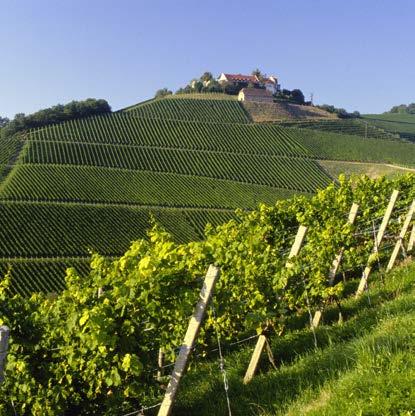
9 minute read
Baden
SPOILT BY THE SUN
Baden, the third largest wine-growing region of Germany, stretches from north to south for some 400 km (240 miles) and comprises 15,800 ha (39,500 acres) of vines. Thus, it is not surprising that the wines produced along the Baden wine road are quite diverse. wine connoisseurs have long agreed that Baden’s wines are “kissed by the sun.” As a result, it is the only German wine region that climatically falls within the eU wine zone B, where minimum ripeness levels are somewhat higher than in zone A. Lots of sunshine and warmth – the warmest places in Germany are in the Kaiserstuhl district – enable vines to ripen very well.
Advertisement
From the Tauber river in the north to the Bodensee (Lake Constance) in the south, Baden is divided into nine districts, each of which has a distinctive landscape and climatic conditions. In the northern portion of the region (Tauberfranken, Badische Bergstrasse, and Kraichgau), Müller-Thurgau, riesling and Schwarzriesling (Pinot Meunier) predominate. The central area (ortenau) is well-known for Spätburgunder (Pinot Noir) and riesling. Further south (Breisgau, Kaiserstuhl and Tuniberg) red and white Pinots take the lead. Gutedel, a white wine specialty, is grown primarily in the district bordering Switzerland (Markgräflerland), while Spätburgunder and Müller-Thurgau thrive in the sites overlooking the Bodensee (Lake Constance).
Baden is the most important German wine region for Spätburgunder. regardless of style and body, Spätburgunder – red wines or weissherbst (rosé) – is extremely popular. Increasingly, velvety, powerful wines are aged in small barrique casks. Not only red Pinots thrive here, but also white Pinots, such as full-bodied Grauburgunder (Pinot Gris) or elegant weissburgunder (Pinot Blanc) or filigree Auxerrois. Badisch rotgold is a rosé-colored speciality made from Spätburgunder and Grauburgunder grapes.
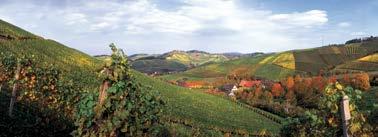
BADEN – AT A GLANCE
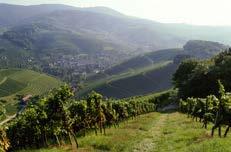
Geographical location: From the Bodensee (Lake or Schwarzwald (Black Forest) to the shores of the Bodensee, Baden appeals to many tourists. They enjoy the mild climate, picturesque wine villages and diverse scenery. Also popular are larger towns, such as Heidelberg, Konstanz, Baden-Baden, Karlsruhe or Freiburg. Those seeking an “active” vacation have much from which to choose, from cycling along the Tauber to a walk or hike along the many signposted vineyard Baden-Baden is perfect for a “wellness day,” at best in combination with wine. Visitors and locals celebrate wine at more than a hundred wine festivals annually. Large fairs feature wines from an entire district; others take place in historical settings in the spirit of medieval traditions. The more than 50 wine-growers’ cooperatives in Baden regularly open the cellar doors to visitors at “open house” events. Two annual wine fairs provide
Constance) along the Upper rhine Valley, to the Kraichgau and Bergstrasse; the Tauber Valley in the region’s northeastern corner · Climate: Sunny and warm; the Kaiserstuhl district is one of Germany’s warmest regions · Soils: Morainal gravel at the Bodensee; Tertiary limestone, clay and marl soils as well as huge loess deposits and volcanic soils in the Kaiserstuhl and Markgräflerland districts; shell-limestone and marl in the Kraichgau and Taubergrund · Size: ca. 15,800 ha (39,500 acres) · Grape varieties: Spätburgunder (Pinot weissburgunder (Pinot Blanc), Gutedel, riesling
From the slopes of the odenwald (oden Forest) paths. one of the several spas between Badenweiler and Noir), Müller-Thurgau, Grauburgunder (Pinot Gris), wine enthusiasts with the best overview of which wines are currently available: the Badische weinmesse in offenburg in May, and the oldest (19th century) wine market in Baden in Müllheim/ Markgräflerland in April.
Information: Badischer Wein GmbH Basler Landstraße 28b 79111 Freiburg Tel. +49 (0)761 89784784 Fax +49 (0)761 89766396 www.badischerwein.de info@badischerwein.de
Baden: Landmarks of German Wine Culture

WEINGUT ABRIL IN BISCHOFFINGEN, BADEN
The first steps into the buildings at Weingut Abril in Bischoffingen are perhaps more reminiscent of the set of a Star Trek movie than a working winery. With its almost austere aesthetic, Weingut Abril has embraced forward-looking principles in both design and product. High-end. Sustainability. With 20 hectares (50 acres) under vine, it is the largest organic winemaker from the Kaiserstuhl region to also be a member of Germany's Ecovin association.
The Future is Now Located on the enselberg, one of the top sites in Baden's Kaiserstuhl region, weingut Abril embraces its dedication to the future. The estate opened its doors in 2012 promising “an entirely new perspective on wine.” This innovative spirit is reflected in its unusual architecture. The rust-hued steel facades are encircled with a gray metal ribbon depicting gnarled vines – a sharp contrast to the rich green of the surrounding vineyards. The estate's innovation continues in its certified organic agricultural practices, marked by a consistent exclusion of chemical/synthetic additives in favor of herbal cover crops, organic fertilizer in the vineyards and all aspects of the cellar work as well. The wines cover a range from riesling and white Pinots (Blanc and Gris) to Pinot Noir, Cabernet and Merlot.
Weingut Abril Vogtsburg-Bischoffingen im Kaiserstuhl, Am enselberg 1 Tel. +49 (0)7662 9493230 www.weingut-abril.de
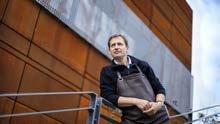
THE HEILIG-GEIST-TORKEL IN MEERSBURG, BADEN
“Life is too short to drink bad wine,” so reads the inscription above the entryway to the Meersburg Wine Museum in the former HeiligGeist-Spital. The museum features a wide collection of artifacts, including a historical cart once used to transport grapes from the vineyards to the press. The goal is to shed a light on the extraordinary winemaking tradition – stretching back over a millennium – of the Lake Constance area.
Conveyors, Casks and Crushers The “Türkenfass” – a richly adorned 50,000 liter cask once belonging to the Knights of the Teutonic order – and a 400-year-old wine press known as the HeiligGeist-Torkel are the prime attractions at the Meersburg wine Museum. The hefty wooden press, whose name is derived from the Latin 'torculum’ or twist, was first constructed in 1607. It remained in active use until 1922, and is now the oldest functional mechanism of its kind in the Lake Constance region. during the 17th century, the ground floor of the infirmary served as a press house, while the upper floor contained a pauper's home for the elderly. The museum opened on the former infirmary grounds in 1961.
Weinbaumuseum Meersburg, Vorburggasse 11 Tel. +49 (0)7532 440400 www.meersburg.de
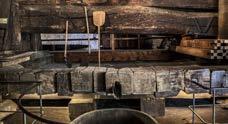
THE REICHENAU – WHERE WATER TURNS TO WINE, BADEN
The highest spot on the Reichenau, the largest island in Lake Constance, is known as the Hochwart. It was there that a tea house with belvedere was built in 1839. Today, the cubic structure is a popular meeting point from which to admire the majestic views over the vineyards, vegetable fields and the lake – and to learn about the island's strong viticultural history.
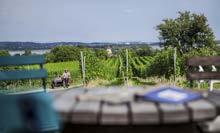
A Natural High, Guaranteed! The monks of the Benedictine monastery first planted vines on the island over 1100 years ago. The mild Lake Constance climate, with plentiful sunshine and relatively low fluctuations in temperature, allowed the monks to build up a massive winemaking operation. Up until the start of the 20th century, almost a third of the island – 140 hectares (346 acres) – was under vine. Today Germany's southernmost winegrowing region counts only 18 hectares (44 acres) of vineyards. The Growers Association of reichenau, the smallest independent winegrowers cooperative in Baden, cultivates both new and traditional varieties: Gutedel, Muskateller, Chardonnay, Spätburgunder (Pinot Noir), Grauburgunder (Pinot Gris), Müller-Thurgau and Kerner. The wines are still pressed in the massive vaulted cellar of the old cloister, albeit using cutting-edge modern technology.
Winzerverein Insel Reichenau e. G. reichenau, Münsterplatz 4 Tel. +49 (0)7534 293 www.winzerverein-reichenau.de
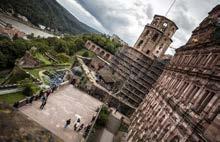
THE GREAT CASK IN HEIDELBERG CASTLE, BADEN
“Ruinen machen vielen Spaß, auch sieht man gern das Große Fass (Visiting ruins is a lovely task, and who can resist Heidelberg's Great Cask),” famed children's author Wilhelm Busch once rhymed. The tourist attraction in Heidelberg Castle continues to draw close to one million visitors each year. It has also graced the pages of such literary giants as Heinrich Heine, Mark Twain, Victor Hugo and Jules Verne – including several mentions in Melville's famous novel regarding another behemoth, “Moby Dick.”
A Cask of Unusual Size The Great Cask is 7 meters (23 ft) wide and 8.5 meters (28 ft) long. A dance floor is erected atop it, accessible via a wooden staircase. The gold initials refer to its constructor, elector Karl Theodor von der Pfalz, who commissioned the enormous vessel back in 1750 in order to hold tithed wines from the electoral Palatinate. It is the fourth great cask built on this spot. In the late 16th century, the Fassbau of Heidelberg Castle was built to house the first great cask. Located directly next to the banquet hall – an especially helpful feature when the grand banquet season arrived – the cask contained 127,000 liters of wine. This, however, was only enough to keep the Heidelberg court supplied for 60 to 100 days. Its replacement, the second Great Cask, could hold 195,000 liters, which covered 120 to 150 days. The third cask bumped that figure up to 202,000 liters... but tended to leak, as does the Karl Theodor Cask, in which over 220,000 liters can be filled.
Heidelberger Schloss Heidelberg, Fassbau Tel. +49 (0)6221 538431 www.schloss-heidelberg.de
WINKLERBERG VOLCANIC ROCK GARDEN IN IHRINGEN, BADEN
Success! Tired but satisfied, the winegrowers and their hard-working harvest team meet at the old vineyard hut. The grapes they've harvested will be used to make fine Kaiserstuhl wine – grown on the Ihringer Winklerberg. This is Germany's warmest vineyard site, with a microclimate that in some parcels ranges into the subtropical. Loess soil, created during the last major ice age, sits atop weathered lava rocks from a volcano that quieted some 15 million years ago. Together they make a powerfully fertile spot for outstanding Pinot varieties, as well as Traminers and Muskatellers, all with a unique volcanic influence.
Lava Fields and Loess Soils The name of the Ihringer winklerberg can be traced to the crooked, labyrinthine design of its vineyards. Although the year 962 marks the first documented mention of this winegrowing town in the southern section of the Kaiserstuhl, wine production in the region had begun long before then. Today winegrowers in Ihringen cultivate roughly 600 hectares (approx. 1500 acres) of vines, including 117 hectares (290 acres) on the winklerberg alone.
Between the steep terraced vineyards, a lingering Mediterranean climate produces citrus fruits, almond trees, orchids and even wild cacti. Bright emerald lizards, praying mantises and other rare wildlife can often be caught sunning themselves on the warm rock walls. The Vulkanfelsgarten, or Volcanic rock Garden, takes a circuitous, 2.4 km (1.5 mile) route around the winklerberg, with stunning views over the Black Forest, Vosges Mountains and Swiss Jura.

Kaiserstuhl Touristik Ihringen am Kaiserstuhl, Bachenstraße 38 Tel. +49 (0)7668 93 43 www.ihringen.de










